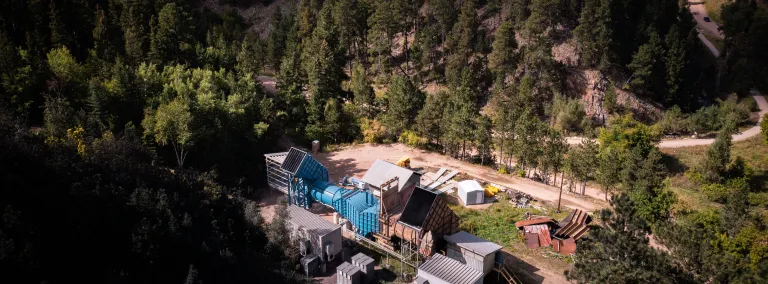Reaching the finish line
A nearly two-year upgrade provides increased airflow, partnerships
For more than a year and a half, the Sanford Underground Research Facility’s (SURF) ventilation system—part by part, unit by unit—has been boosting the underground airflow. As the engineering team at SURF nears the finish line of the Oro Hondo fan complex upgrade with final commissioning starting this week, this latest completion is poised to serve the future expansion and growth of the research facility.
Engineers Andrew Brosnahan and Jason Connot shared insights about the project and how this upgrade will increase reliability needed to support the 24-hour underground excavation for the LBNF/DUNE (Long-Baseline Neutrino Facility and Deep Underground Neutrino Experiment).
“Increasing from 242,000 CFM (cubic feet of airflow per minute) to 310,000 CFM, which is within the excavation requirements, allows work in all three caverns at once,” said Connot, underground operations engineer.
Facility engineer Brosnahan, project manager for the upgrade to the ventilation complex, noted this project offered the opportunity to work with teams across SURF. “Coordination with the outages impacted everybody sitewide,” said Brosnahan who added that this is a process he may utilize in future projects that could stretch across the entire 233-acre site.
He also recognized the benefit of working with local companies, boosting the economic impact of the project throughout the region. “RCS Construction based in Rapid City and Elite Industrial, LLC out of Gillette, Wyoming helped throughout the upgrade.”
Connot has worked with his team to configure the underground airflow as the improvements in the ventilation system have altered the flow of air underground. About 1,000 feet above the DUNE excavations, changes were made to move the airflow toward the developing caverns.
“We were not planning on it, but we restricted the air moving through the 3500 Level to force it down.” Connot’s team uses velocity readings and pressure surveys to monitor the airflow as part of routine operations. He continually reviews a three-dimensional map on his computer that provides insights from where the air enters through where it exits the extensive underground levels.
Every summer, SURF hires interns to work in different areas of the facility, including engineering. As part of the ongoing Oro Hondo fan operation, SURF interns learned how to observe conditions and take the necessary surveys and readings. “We incorporate field study necessary for future jobs,” said Connot, who worked with two engineering students from South Dakota Mines during a portion of the Oro Hondo complex upgrade—a partnership that continues to integrate the work of SURF with the STEM priorities of the nearby university.
Learn more about past Oro Hondo complex work supporting the continued development and growth of SURF.
